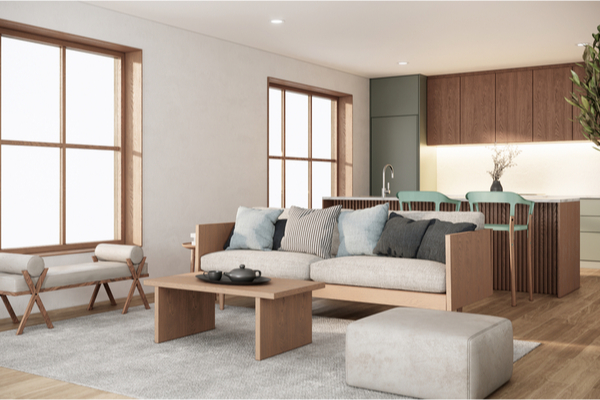Home decor trends are always changing, but when it comes to 2022—a new year on the tails of some pretty challenging times—one phrase rings true for everything from home design to our daily lives: according to Designer & Manager of Production Design at Living Spaces, Jessica Harris, things will be perfectly imperfect.
As Harris notes, next year’s trends highlight the beauty of the symmetrical, uneven, or unbalanced things. “This trend is all about seeing flaws as an asset or something that makes each piece unique,” she shares, “It appreciates the effects of time, and the humble beauty found in things that are impermanent old, worn, or incomplete.”
One trend to look out for is Japandi style, an interior design aesthetic that blends Japanese and Scandinavian approaches, is everywhere right now. Refinery29 reports that while the portmanteau has been around since 2016, it’s popularity has accelerated in recent years, with searches peaking in September 2021, according to Google Trends, and now it’s been predicted to be one of the more prevalent design trends of 2022. But what is it exactly? Why does it have such long lasting appeal?
To understand Japandi, it’s worth looking first at the two cultures it draws from. Scandinavian design as we know it now (encompassing the regions Denmark, Sweden and Norway) is defined by its clean, simple lines and a focus on functionality, without compromising on beauty.
“This is a Scandinavian-Japanese mix for interior design,” says Harris. “It is very minimalist… It brings a lot of natural elements into a space with [a] muted palette, natural light, plants, and clean simple lines. I love the idea of styling with greenery from one’s own home, like finding oversized greenery in your yard and bringing a dramatic stylist element into the room rather than going out and buying plants,” she says.
Japandi combines the way both cultures use natural materials, simplicity and craftsmanship. According to head of interiors Gemma Riberti and director of interiors Lisa White at trend forecaster WGSN, the use of pale woods as the material foundation, as well as the focus on light and airy spaces, make a space where the two palettes can work together. With Japandi, “a tranquil muted palette of pastel and cool colour schemes from Scandinavia is applied to soften the hard surfaces, juxtaposed to darker stained timbers, stone, and indigo elements from the Japanese style.”
“Both cultures contribute to the softly minimalist values that Japandi adheres to,” they add. “[Japandi] blends and mixes these colour hues together, creating dramatic contrast while maintaining balance.”
The aesthetic meeting point of Japandi also incorporates the Japanese concept of wabi-sabi (embracing the beauty of simplicity and impermanence) and the Danish concept of hygge (finding cosiness in life’s simpler pleasures).
While use of the term ‘Japandi’ is relatively new, the connection between the two cultures dates further back. According to Architectural Digest, the melding of styles originated when Danish designers and creatives began traveling to Japan in the late 19th Century, when the 220-year-old closed-border policies were finally lifted. AD reads: “Early traces of this design style can be seen in ceramic crafts, architecture, and Danish furniture.”
The appeal of these two design approaches outside of their regions comes from the focus on creating spaces that are soothing and ordered, with room for creative expression. The cool elements of Scandinavian interiors are cosied up and softened by the considered tactility of Japanese references. Crucially, it’s not soulless. As Gemma and Lisa put it, “it is very important to underline that this direction is the opposite of cold minimalism: it is warm to the hand and to the eye, it calls to be lived in and it feels relatable rather than aloof.”
It’s unsurprising then that this is a design approach people are so drawn to now. After being forced to make peace with our clutter and looking for new ways to fill our homes with happiness, creating an environment that feels simple, functional but full of heart is intriguing. Jen Hore, Brand and Social Lead at Trouva, the online retailer for independent boutiques, said in an interview with Refinery29, that customers are now looking for interiors that inspire as well as soothe. “We saw a huge shift last year to homewares that sparked joy through bright, bold and clashing colours. This has been tailing off for a little while now as customers favour homewares crafted in natural materials and in a range of neutral palettes.”
—
Photo Credit: CREATIVE WONDER / Shutterstock.com
